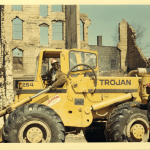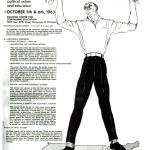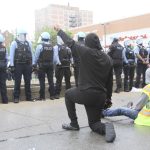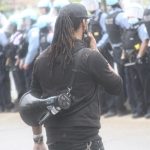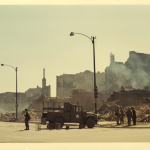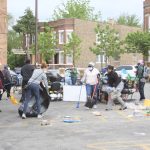Resistance: The Aftermath is on display on the 8th floor Arts and Music department of Harold Washington Library Center from September 20, 2023, to April 2, 2024. The exhibit features the work of contemporary Chicago photographer Danny Ingram alongside archival photos from Chicago Public Library collections. In collaboration between the African American Heritage Committee and the Chicago Public Library Exhibits Unit, this project explores the history of Black protest in Chicago, highlighting its effects on both the nation and the neighborhood.
South Shore Through Danny Ingram’s Lens
Danny Ingram is a veteran of the United States Army and has been a professional event photographer for more than 25 years. Amidst the civil unrest following the 2020 murder of George Floyd, Ingram turned his lens on the streets of South Shore. His photographs depict Black Chicagoans’ struggle to have their grievances – and their humanity – recognized on a larger scale.
Of the photographs featured above, Ingram writes: “Through this work, I wanted to capture the power of despair and hopelessness to the desire for change. Segregation and marginalization in any form is wrong, and the truth cannot be filtered or contained even amid a pandemic.”
Protest in the Archives
The archival images in this exhibit, all drawn from the Vivian G. Harsh Research Collection, show protest and what comes after. Photographs from the Sylvia Campbell photograph collection, taken by Henry Campbell, demonstrate the power of human anger and the devastation of the African American community in the wake of Dr. Martin Luther King Jr.’s assassination. Campbell’s East Garfield Park photography business was among those destroyed and he chose not to rebuild it.
Selections from the Timuel D. Black, Jr. papers depict the 1963 March on Washington for Jobs and Freedom. Black, a teacher, World War II veteran, activist, author and historian, served as the Chicago coordinator for the March, with remarkable success – thousands of students returned to Chicago galvanized for change. Also featured in this exhibit are photographs of the 1963 sit-in demonstrations at the Chicago Board of Education, where activists from the Congress of Racial Equality, Chicago Chapter demanded improved education facilities for Black communities and an end to low-quality mobile classrooms. Later that year, organizers came together around the “Freedom Day” boycott of segregated Chicago Public Schools.
Together, these images demonstrate that although much has changed in the 50 years since Freedom Day, much remains the same. We invite you to view the exhibit and consider this legacy of protest, its costs and its triumphs.


